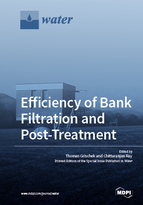Efficiency of Bank Filtration and Post-Treatment
A special issue of Water (ISSN 2073-4441). This special issue belongs to the section "Wastewater Treatment and Reuse".
Deadline for manuscript submissions: closed (28 February 2019) | Viewed by 101678
Special Issue Editors
Interests: bank filtration; managed aquifer recharge; subsurface water treatment; iron and manganese removal
Special Issue Information
Dear Colleagues,
Bank filtration (BF) schemes for the production of drinking water are increasingly challenged by new constituents of concern, such as organic micropollutants and pathogens in the source water and hydrological flow variations due to weather extremes. Bank filtration and new technology components are integrated and monitoring and operating regimes are adopted to further optimise water treatment in bank filtration schemes for these new requirements. The special issue will present first results from the EU-project AquaNES “Demonstrating synergies in combined natural and engineered processes for water treatment systems” (www.aquanes.eu). Papers from other research groups and especially water companies are invited covering the efficiency of bank filtration and post-treatment, advantages and limitations of combining natural and engineered processes or parameter-specific assessment of removal rates during bank filtration and further treatment. Additionally, contributions from Asia and Africa are invited dealing with feasibility, design or operation of BF schemes under specific site conditions. Papers dealing with energy efficiency and cost evaluation of BF are also welcome.
Prof. Dr. Thomas Grischek
Prof. Dr. Chittaranjan Ray
Guest Editors
Manuscript Submission Information
Manuscripts should be submitted online at www.mdpi.com by registering and logging in to this website. Once you are registered, click here to go to the submission form. Manuscripts can be submitted until the deadline. All submissions that pass pre-check are peer-reviewed. Accepted papers will be published continuously in the journal (as soon as accepted) and will be listed together on the special issue website. Research articles, review articles as well as short communications are invited. For planned papers, a title and short abstract (about 100 words) can be sent to the Editorial Office for announcement on this website.
Submitted manuscripts should not have been published previously, nor be under consideration for publication elsewhere (except conference proceedings papers). All manuscripts are thoroughly refereed through a single-blind peer-review process. A guide for authors and other relevant information for submission of manuscripts is available on the Instructions for Authors page. Water is an international peer-reviewed open access semimonthly journal published by MDPI.
Please visit the Instructions for Authors page before submitting a manuscript. The Article Processing Charge (APC) for publication in this open access journal is 2600 CHF (Swiss Francs). Submitted papers should be well formatted and use good English. Authors may use MDPI's English editing service prior to publication or during author revisions.
Keywords
- River bank filtration (RBF)
- Lake bank filtration (LBF)
- Water quality changes
- Post-treatment
- Coupling BF and innovative post-treatment
- Membrane filtration
- Removal of bulk organics, trace organic compounds and pathogens







